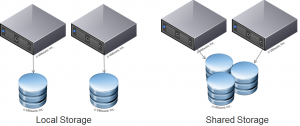Reading Time: 3 minutesSome weeks after the announce of the DynamicOps acquisition intent, VMware has announced it has signed a definitive agreement to acquire Nicira, a pioneer in software-defined networking (SDN) and a leader in network virtualization for Open Source initiatives.
VMware will acquire Nicira for approximately $1.05 billion in cash plus approximately $210 million of assumed unvested equity awards. The acquisition is subject to regulatory approvals and other customary closing conditions. The parties expect the acquisition to close during the second half of 2012. The acquisition has been approved by the boards of directors of both VMware and Nicira and the stockholders of Nicira.
But what is the Software-Defined Datacenter? Basically could be the foundation of Cloud Computing. Cloud computing is about agile, elastic, efficient, and reliable services, and it is achieved through sophisticated software that abstracts hardware resources, pools it into aggregate capacity, enabling automation to safely and efficiently dole it out as needed for applications. Tenants or customers utilizing the software-defined datacenter can have their own virtual datacenter with an isolated collection of all the compute, storage, networking, and security resources that they are used to. Furthermore, this virtual datacenter can grow and shrink to efficiently utilize physical resources. This is what the software-defined datacenter is all about, and it is the architecture for the cloud. Managing networks and network services to support cloud architectures is complex, time consuming and limits the achievement of full application mobility across clouds. Nicira is at the forefront of software-defined networking, which enables the dynamic creation of virtual network infrastructure and services that are completely decoupled and independent from the physical network hardware. Many industry leaders, including AT&T, DreamHost, eBay, Fidelity Investments, NTT and Rackspace are using the Nicira Network Virtualization Platform (NVP) to accelerate service delivery from weeks to minutes and dramatically reduce complexity and cost.
For more information see also:
VMware has also announced financial results for the second quarter of 2012:
- Revenues for the second quarter were $1.12 billion, an increase of 22% from the second quarter of 2011, and 23% measured in constant currency.
- Operating income for the second quarter was $212 million, an increase of 13% from the second quarter of 2011. Non-GAAP operating income for the second quarter was $358 million, an increase of 23% from the second quarter of 2011.
- Net income for the second quarter was $192 million, or $0.44 per diluted share,compared to $220 million, or $0.51 per diluted share, for the second quarter of 2011. Non-GAAP net income for the quarter was $296 million, or $0.68 per diluted share, compared to $235 million, or $0.55 per diluted share, for the second quarter of 2011.
- Trailing twelve months operating cash flows were $2.05 billion, an increase of 33%. Trailing twelve months free cash flows were $2.01 billion, an increase of 29%.
- Cash, cash equivalents and short-term investments were $5.3 billion and unearned revenue was $2.9 billion as of June 30, 2012.


 (how use Nutanix with a VDI environment)
(how use Nutanix with a VDI environment)









 DataCore Software
DataCore Software
